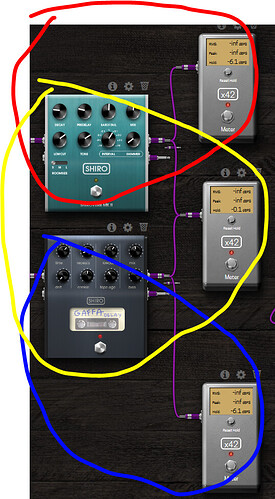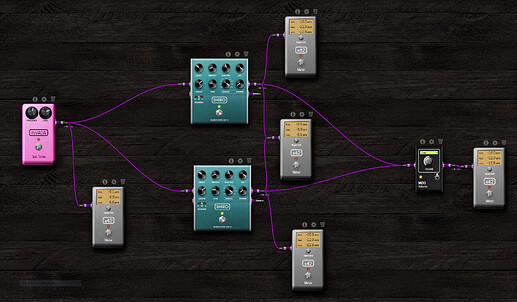As you can see (and already discussed in the past), merging 2 separate channels into 1 channel adds 6 dBFS. Obviously this is pretty annoying and hard to manage. Will this be solved with future updates?
I think the simplest solution would be to put a mixer to the right of the 2 effects.
Hi @redcloud
I would solve this with a volume plugin after these 2 effects like below.
Depending on the complexity of the pedalboard a mixer like @malfunction54 suggested could be a better solution.
I agree with you that it’s annoying but what I think it is even worst the fact that the dry/wet mix structure of the plugins differs a lot.
Some of them let the dry signal “bleed” into the mix even when we have set to “all wet” and that makes trick to manage volumes down the signal path especially if you mess a lot with the parameters when live playing.
You may save a pedalboard state that later on can make no sense.
Indeed that’s the fastest workaround. Would be easier to manage automatically by the platform if every plugin were forced to add a volume parameter, I guess.
Hello @redcloud ,
in this case every single plugin developer would have to integrate such code into their LV2 plugins or plugin code had to be forked and adapted for the mod ecosystem by the mod developers themselves.
This is possible but costs precious time for developers inventing something new in the mod ecosystem instead.
Nevertheless it would be really nice to have, I agree.
Sorry to interrupt your thoughts and ideas, here this post as a general feedback could become a feature request, at least from my side.
Another option is to use the Audio file player that comes with some repeatable guitar and bass riffs.
I don’t know if these have the right level, I would propose -18dBFS RMS level wise.
You could even record a sound snippet yourself in front of your pedalboard and check with the level meters at different positions.
Maybe this process could be automated for the effects chain you build, at that point when you hit save pedalboard. I mean to test your pedalboard with a defined input source so that the output would not exceed 0dBFS while the output is muted and the pedalboard is about to be saved.
Another thought about the process: Automating such a level test procedure should give you feedback
about whether the level of your signal chain is too weak or too loud, or even off by x amount of dBFS.
You have built your effects chains to your liking but this level test wouldn’t recognize about your perfect signal ratio between chain A and chain B and the cause for that level issue at the end.
Time for me to shut up.
I am sorry if my thoughts are off-topic or irrelevant for this case.
Greetings and God bless, Marius
Thanks for the suggestion! This is my current workflow to make things work on the volume level side. I agree that it really depends on the chain complexity and was looking for a “general purpose” automated solution. But probably it would require a big effort to develop on MOD side.
I don’t really see this as a problem, and certainly not a problem with MOD specifically. As far as I’m aware, this is just how digital audio typically works. Mixing two signals together basically adds them together, so if you start off with two correlated signals of the same amplitude and mix them together you’ll end up with a signal which is twice the amplitude (i.e. 6dB louder).
From a purely technical perspective, it I don’t think it would be difficult to build in a fixed volume drop when mixing two signals together. However, it’s impossible to know in advance how big that drop should be. In your screenshot, the two input signals are both carefully calibrated to be the same level, so 6dB isn’t surprising. In general though, the input signals could be anything, so the volume drop needed might be anything.
E.g. Maybe you’re using a switchbox to select between two different signal paths and are mixing them back together at the end of the chain. In this scenario, one of the signal paths is always silent and contributes nothing. Suppose you carefully calibrate both paths to peak at -6.1dB. Then you mix them together, the output level is -6.1 + 0 = -6.1dB, which is what you want. But then the system automatically applies a 6dB pad and you end up with an output at -12.1dB. Then you would need to add a gain plugin to apply 6dB of gain and get you back up to -6.1dB. So (a) you end up with a more complicated pedal board than needed and (b) the processor is using up CPU cycles to reduce gain and then immediately increase it by exactly the same amount to get back to where it started.
So, generally speaking, it’s more efficient to mix signals together by simply adding them together, then let the user add gain plugins if needed to get the the level they want.
It probably wouldn’t be too difficult to create a plugin to mix signals based on some other method, e.g. take the average of two inputs rather than adding them. That wouldn’t really add to the capabitilies of the MOD but it might simplify some pedalboards and possibly save a few CPU cycles if implemented well?
Of course it is not a problem for “experienced” users but if you want to “compete” in the world of guitar modeling (which is the main role of Dwarf, I suppose) you (MOD) have to simplify things for the end user. As far as I know, modern modelers solve this problem automatically.

